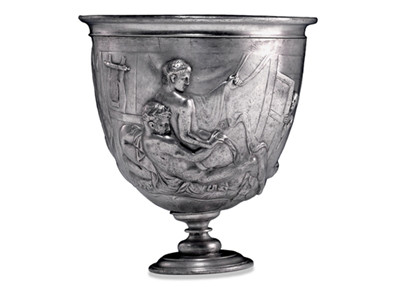"What you have on this cup are two different varieties of a homosexual act. On the front you've got an older man, and we know he's older because he's got a beard. Sitting astride him is a very handsome young man, it's all very vigorous and virile. This is kind of 'camera virite' if you like, I mean it's very realistic-this isn't an idealised view of homosexuality. What's quite interesting, if you go around the back, is here you've got something which is more a kind of standard portrayal of homosexuality; two very beautiful young men-we know that they're young because they've got locks of hair hanging down their backs-one is lying on his back, and the slightly older man is looking away. It's a lot more kind of lyrical, a rather idealised view of what homosexuality was."
銀杯上刻畫了兩種不同的同性性愛。正面是一位有胡子的成年男性,身上跨坐著一位英俊少年。性愛的動作被刻畫得陽剛有力,也十分逼真,但這并非理想化的同性性愛場景。不過如果你轉到背面,便會看到一場更為標準的同性性愛。人物是兩個英俊的青年男子:垂到背上的發縷表明他們還十分年輕。一人側躺著,年紀稍大的那位則看向另一邊。這是更抒情、更理想化的同性性愛場面。
Although the homosexual scenes on the cup are ones that today strike us as explicit-some might say shocking and taboo-homosexuality was very much part of Roman life. But it was a complicated part, tolerated but not entirely accepted. The standard Roman line on what was acceptable in same-sex coupling is neatly summarised by the Roman playwright Plautus in his comedy 'Curculio':
盡管杯子上的場景在今天看來過于露骨,甚至有些驚世駭俗,觸犯了社會禁忌,但在當時的羅馬卻是十分平常。不過這里的情況有些復雜,社會雖能容忍,但并非人人都能接受。羅馬劇作家普勞圖斯的喜劇《象鼻蟲》中有一段話,大致能概括當時羅馬人對同性戀的態度:
"Love whatever you wish, as long as you stay away from married women, widows, virgins, young men and free boys."
“想愛誰就愛誰,只要不是已婚婦女、寡婦、處女、年輕男性和自由民男孩。”
So if you wanted to show sex between men and youths who weren't slaves, it made sense to look back to the age of Classical Greece, where it was normal for older men to teach younger free-born boys about life in general, in a mentoring relationship that included sex.
因此,如果你想要表現成年男性和非奴隸少年之間的性愛,把場景設置到古希臘時期會是個合適的選擇,在古希臘,由成年男子教導少年如何生活是十分普遍的事,那是一種包含性行為在內的師生關系。












